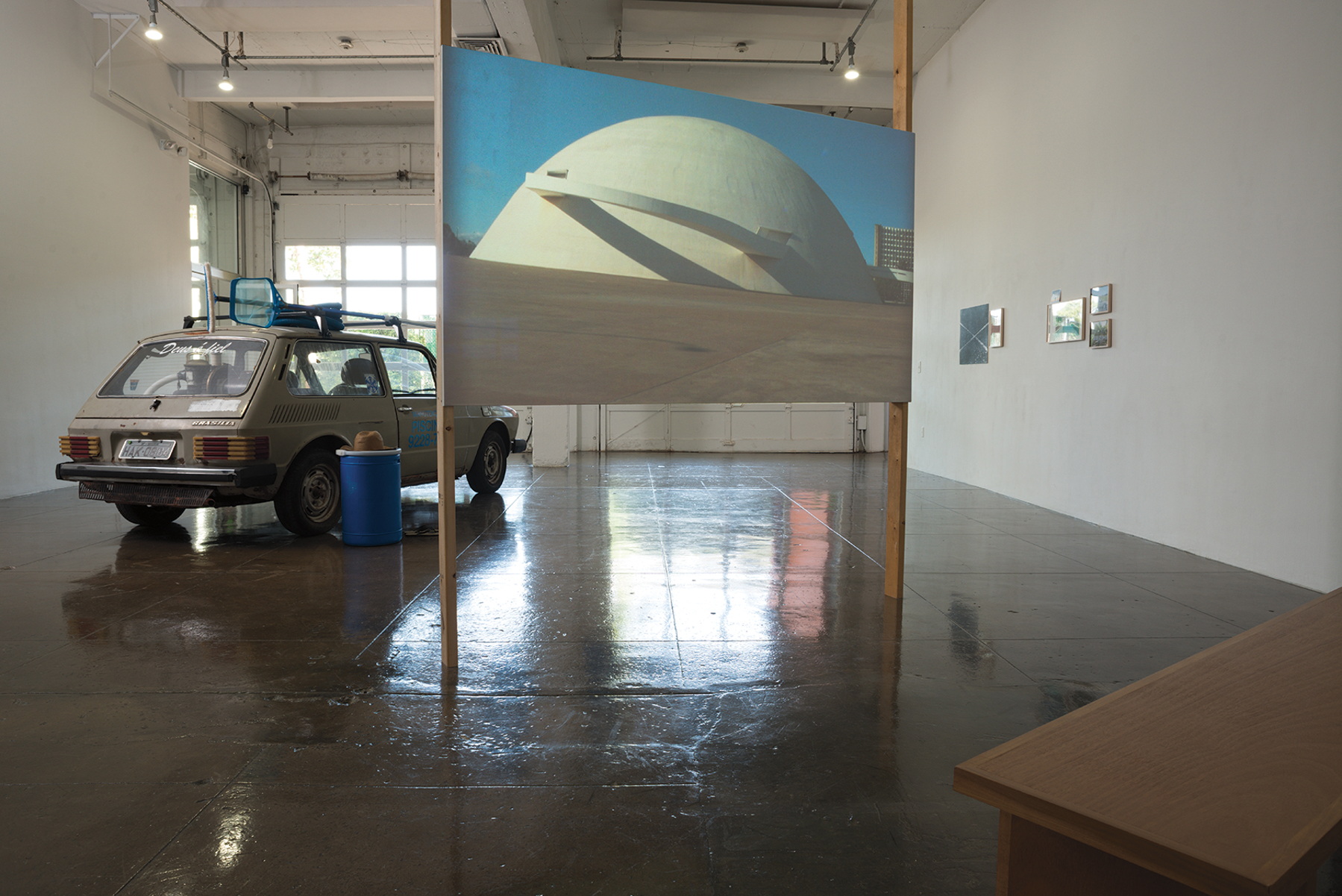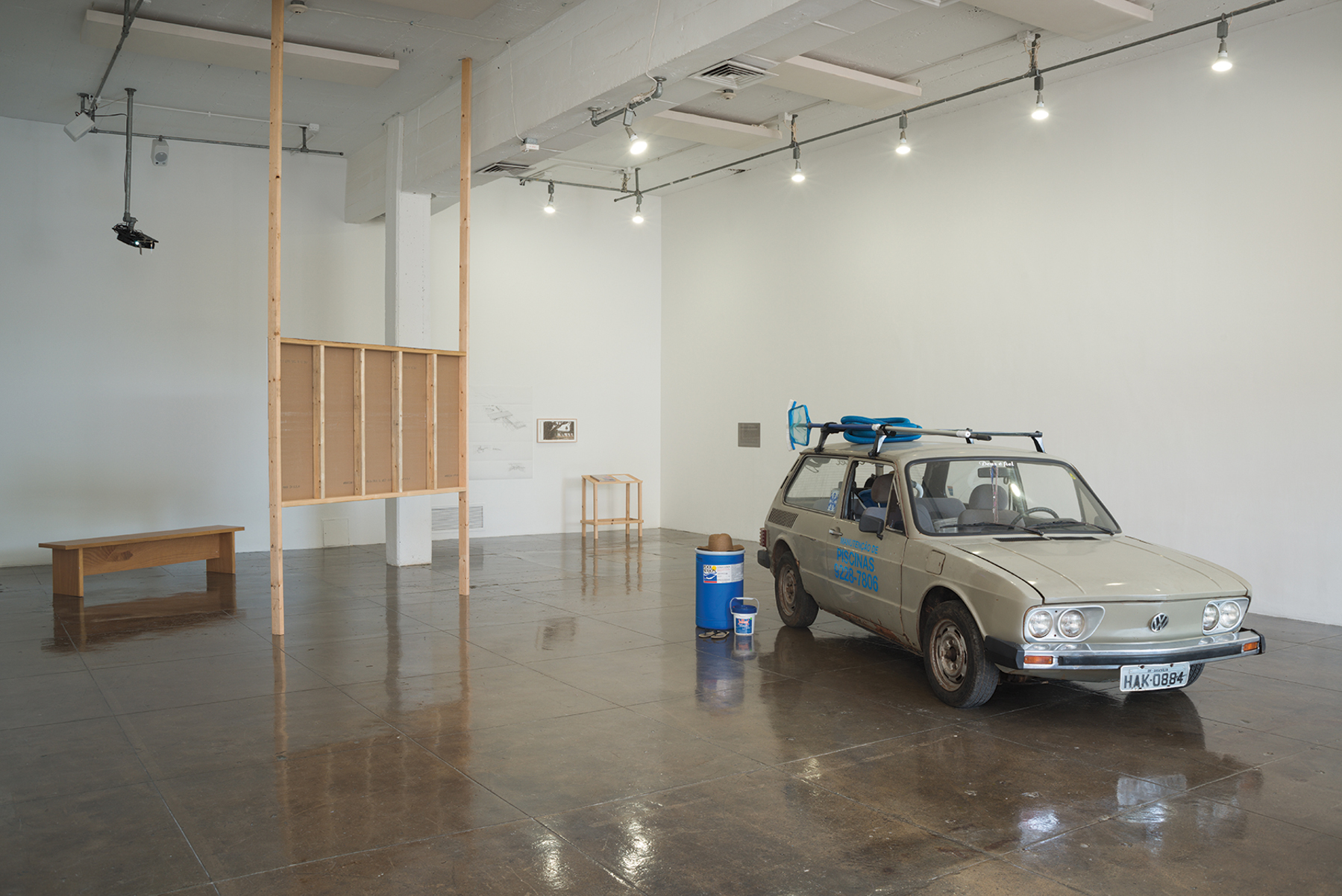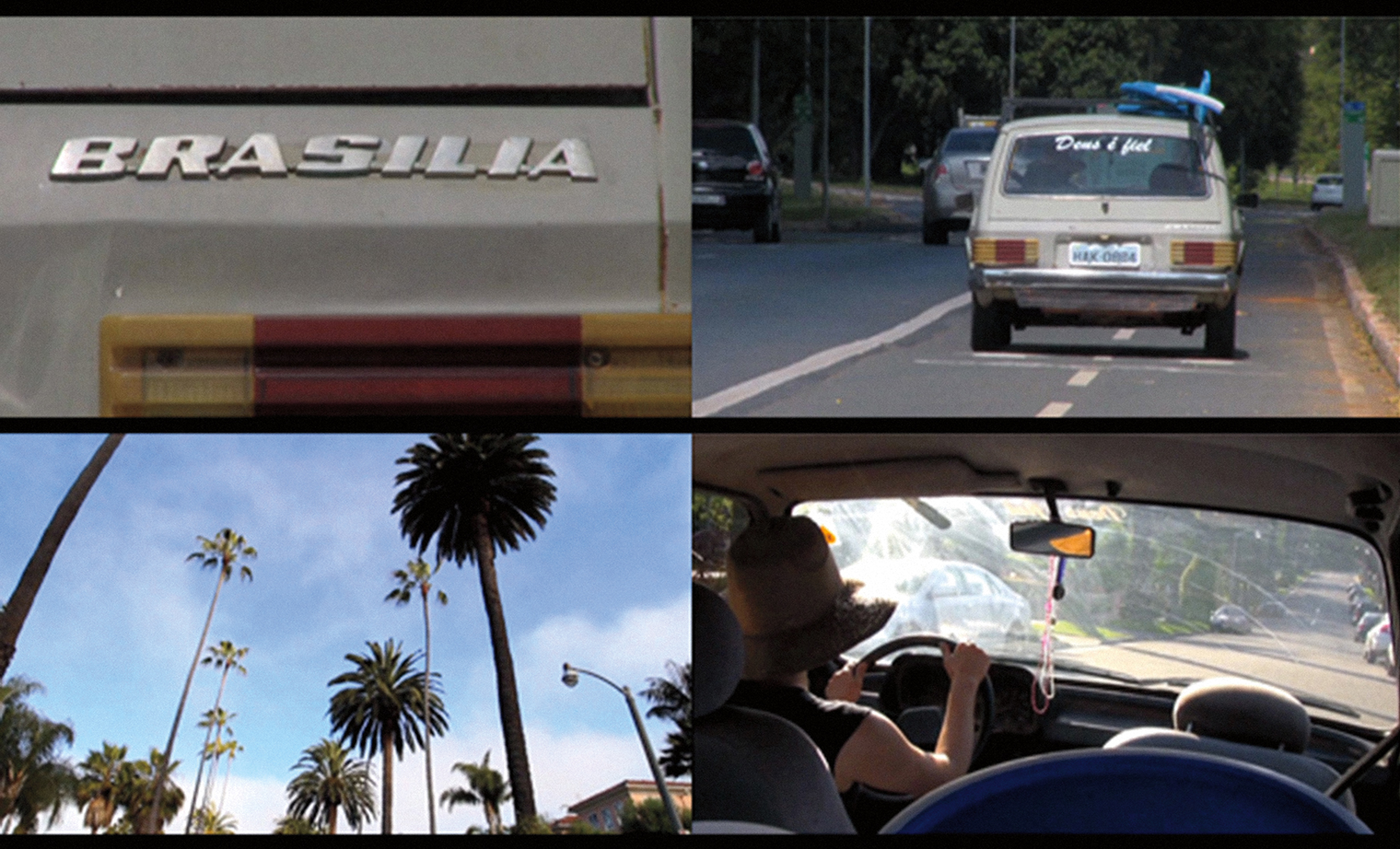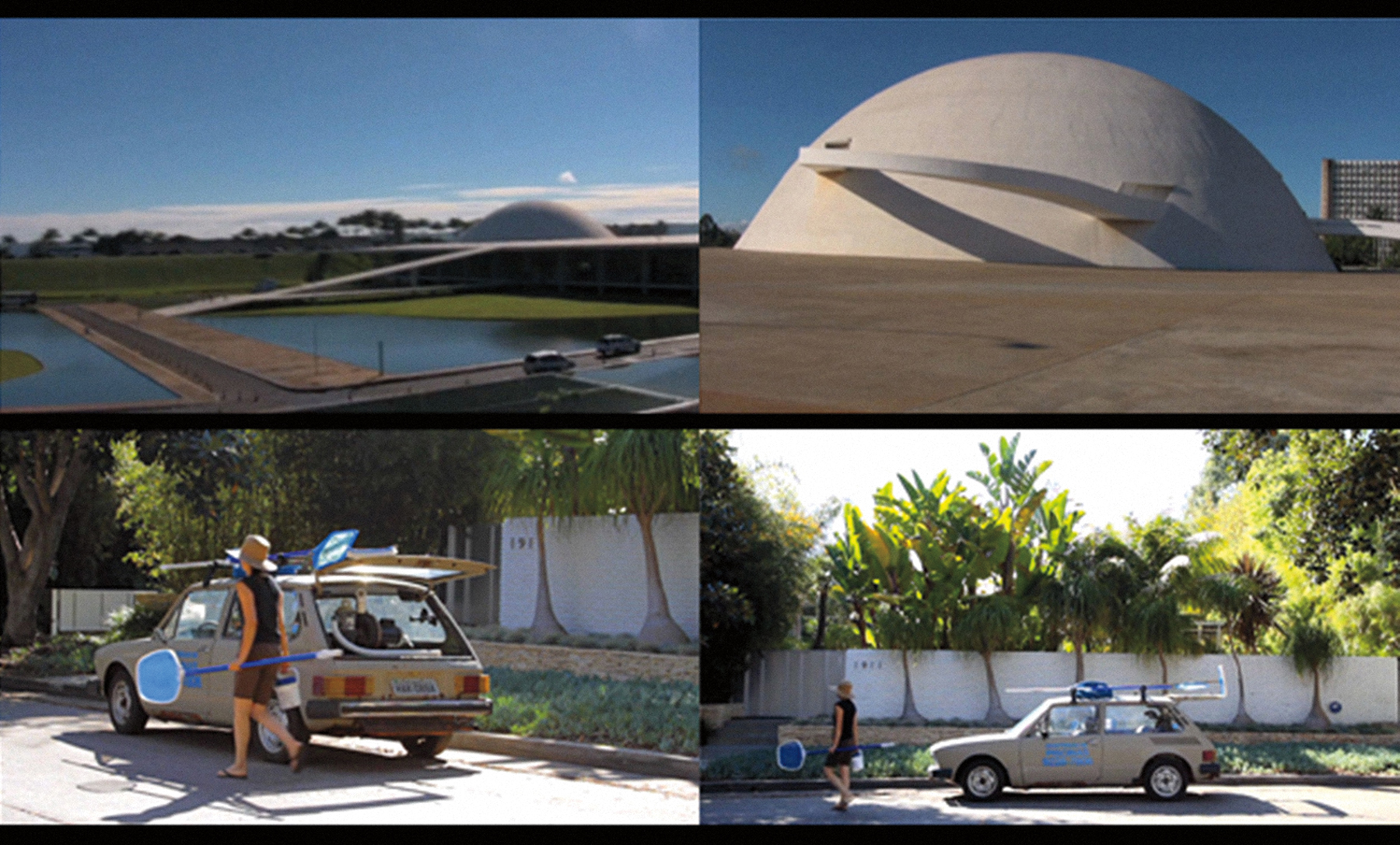Over the past few years, Los Angeles-based artist Clarissa Tossin has been creating portraits of her native Brazil. Through a series of works that include video, sculpture, photography, and site-specific actions that respond to the architectural creations of fellow Brazilian Oscar Niemeyer, Tossin has explored the contradictions inherent in the famed architect’s practice. A self-proclaimed communist,1 Niemeyer aimed to produce an architecture that was “for the people,” yet the conditions and contexts that produced his work resulted in underlining (and perhaps further entrenching) the social and class divisions that existed (and continue to exist) within Brazil.
Tossin’s White Marble Everyday (2009) exemplifies this incongruity. The looped video depicts three workers using rudimentary methods to clean the Niemeyer-designed white marble courthouse in Brazil’s capital, Brasília. Using a watering can to dispense cleaning solution, industrial squeegees, and copious amounts of water, the workers reveal that maintaining the building’s opulence depends on the labor of the working class. In another work, the performative action/video Monument to Sacolândia (2010), the artist commemorates the former housing site of the workers who built Palácio da Alvorada, the presidential palace in Brasília. Called Sacolândia (Bagland), the workers’ residence was fabricated from leftover cement bags that were used to build Palácio da Alvorada. When construction on the building was completed, Sacolândia was flooded to build the artificial lake Paranoá, on the palace grounds, and the workers were relocated to an area outside of the city. Tossin responds to this history by constructing a model of the presidential palace from cement bags, which is then floated on Paranoá and recorded on video. Tossin thus highlights the failure in the architect’s schema—as well as the overall failure of Modern architecture’s conceit—to level the social strata of the city of Brasília and, by extension, Brazil.

Clarissa Tossin, White Marble Everyday, 2009. Two-channel HD video, 5’42” (loop). Courtesy the artist.
Tossin’s practice also documents the ways the architecture and mapping of the city predicate how specific bodies traverse the cityscape. In her print-based series Brasília by Foot (2009–13), she begins with an appropriated Google satellite image of the city that exposes the footpaths made by pedestrians through the grassy sections of the city, which are contained within roadways. Using this image as a guide, Tossin re-traces the footpaths and then documents her walks in a series of prints, each one named after the number of steps required to complete the walk. She uses the soil from the ground as a base for the ink used to make the prints. As presented in Tossin’s projects, most workers, who typically lack the wherewithal to own vehicles, become conversant with the interiors and exteriors of architectural spaces either through their labor, like the marble cleaners, or through intimate methods of mobility, such as walking or cycling. These interactions are often determined by economics or class and do not afford the mediated experiences of either architecture or the outdoors that one experiences in a vehicle. Cumulatively, a structurally and hegemonically enforced interior and exterior emerges in Tossin’s works, where the interior is privileged.
In Brasília, Cars, Pools and Other Modernities (2013), Tossin continues probing the paradoxes inherent in Niemeyer’s architecture, but her focus shifts slightly. In this show, which is the result of her artist’s residency at Artpace, Tossin brought together a series of objects that reveal similarities between the locales of Los Angeles and Brasília. Specifically, the artist draws our attention to the entrenched car cultures and pool cultures that these two “tropical” cities share. The work in Brasília, Cars, Pools and Other Modernities revolves around the history of Brasília. The inauguration of the city as the nation’s new capital in 1960 was intrinsically tied to the re-mapping of that terrain through urban planning, in tandem with the predominantly Niemeyer-designed architecture that gave the city its character. Perfectly timed with a surge in the Brazilian automotive industry, the city was modeled around the infrastructure of the highway and the modern notion of progress.

Clarissa Tossin, Brasília, Cars, Pools and Other Modernities, 2009–2013. Volkswagen Brasilia, cleaning pool equipment, single-channel video, photographs, book, aluminum plaque, letter, photo transfers and drawing. Originally commissioned and produced by Artpace San Antonio. Photo: Todd Johnson.

In Tossin’s sparse installation at Artpace, the pieces on display are a combination of readymade or found objects and handmade things by the artist that work together to illustrate this history of class stratification and labor, particularly the associated threads of manufacturing and industry that assisted Brazil in transitioning to the next phase in its development. Placed at eye level along one wall in the gallery space is a black-and-white aerial view of Brasília. In the grainy photograph, intersecting roadways resemble swaths cut in a field. This image is paired with a framed advertisement for the Volkswagen Brasilia—a now-defunct hatchback that was developed and produced in Brazil, from the seventies to early eighties, for the domestic market and later exported to other South American countries, Mexico, and the Philippines. In Portuguese, the ad for the VW proclaims: “Brasilia. Proven success even in the most difficult paths.”2 These two found images speak to the dependency on both vehicles and driving culture that exists in Brasília, but also to the sense of forging new paths so integral to the era. Across from this pairing is a framed photo that presents a panoramic view of the pool at the Niemeyer-designed Strick House (1964) in Santa Monica, California. This residence was Niemeyer’s only solo architectural project realized in North America (although he co-designed the United Nations Headquarters, in 1953, in New York City with Le Corbusier). A postcard of another Niemeyer-designed building, The National Congress, a government edifice located in Brasília, rests atop of the frame. Alongside the print of the Strick House are two smaller framed photographs of a VW Brasilia. One depicts the car parked in Brasília; the other shows the same car parked in front of the Strick House in California. The adjacencies and juxtapositions in this composition collapse the functionality—private and public—of the two types of depicted structures. At the same time, the presence of the same VW Brasilia in both locales collapses the distance between Brazil and California.
Clustered on the opposite end of an adjacent wall is another collection of materials: a hand-drawn sketch of the Strick House on vellum by Tossin, which is hung beside a framed view of the façade of the Strick House, and a wood podium that holds a sealed copy of the book Modernist Paradise and a typed letter addressed to Niemeyer. In close proximity is a plaque that proclaims the Strick House as a Santa Monica landmark (a replica, one assumes). The floor of the gallery is prominently occupied by an actual Volkswagen Brasilia, replete with pool cleaning supplies. The presence of the automobile simultaneously calls forth the hopes for a new era of modernity in Brazil, the failures of such urban planning, and the seduction of car culture. These points are driven home by a folded newspaper (from 2013) placed on the seat, which boasts the headline: “Brazil’s love affair with the car leaves public transport trailing.”

Clarissa Tossin, Brasília, Cars, Pools and Other Modernities, 2009–2013. Single-channel HD video, 10’05”. Part of the installation of same name. Video still. Originally commissioned and produced by Artpace San Antonio. Courtesy of the artist.

Certain objects presented in Tossin’s installation highlight tensions between work and leisure, upper and lower classes, and utilitarian and utopian concerns. Due to its low cost and the ease with which it transports tools, the VW Brasilia was commonly used in Brazil by pool cleaners and other workers performing maintenance for the wealthy. Likewise, the National Congress building was the site of recent protests centering on the rising cost of public transportation, demands for free and accessible public transit, and the exorbitant costs related to the World Cup soccer event that will be held in Brazil in 2014. Tossin’s rendering of the Strick House in black ink on vellum contains three sketches: one provides an aerial view of the house and grounds, complete with pool, while the other two are cross sections of the home’s interior. The sketch replaces the blueprints one would expect to represent the design plan and attests to Tossin’s own labor in producing it. Viewers who regard the photographic images of the Strick House are unlikely to reflect on those whose labor produced the structure. The average art viewer will associate it with mid-century Western architectural modernism, as well as with a middle-class or affluent standard of living. Yet Tossin disrupts this type of reflective myopia. Each separate element of the exhibition is strategically chosen because of how it represents a particular historical moment of Modernism in Brazil and is positioned to draw us closer to an ultimate resolution, which is a final encounter with the Strick House.
Joseph Strick, a filmmaker, discovered Niemeyer’s work during a visit to Brazil for a film festival. Subsequently, Strick and his wife Anne, who were purportedly enamored of Niemeyer’s politics, commissioned the architect to design their Santa Monica home. Denied a visa to the United States, due to being a socialist, Niemeyer was unable to view the building site in person. He designed the house based on aerial photographs and topographical surveys and oversaw construction through letter correspondence. Tossin responds to this predicament through two specific actions. In the first, a typed letter, the artist writes to the deceased architect and recounts her dismay upon learning that the current owner of the Strick House, who positions himself as an admirer of Niemeyer’s aesthetic, purports to have no interest in either the architect’s political leanings or the utopian ideals that informed his work. In the second response, the artist makes the trip that the architect himself was unable to make during construction. The journey is documented in a sculptural video installation on one end of the gallery. From one side, a makeshift screen constructed with two-by-fours resembles a highway road sign. On the other side of this structure, a projected video features the artist supposedly driving the VW Brasilia from Brasília to Santa Monica in order to perform a pool cleaning routine at the Strick House. The video begins with a shot of a skimmer being dragged through azure pool water, then cuts to Tossin entering the car in Brasília. Alternating between vibrating interior footage with a loud humming emanating from the car’s motor and steady exterior shots of the car traversing a vast expanse of highway overpasses, the narrative leads up to the artist emerging from the car after it is parked in front of the Strick House. In the final scene, she retrieves pool cleaning supplies from the trunk and knocks on the gate to the backyard.
It is here that the shift in Tossin’s work is most visible. Unlike several of her prior works, in which the artist documents the actions of others or provides an overt interrogation of the work of Niemeyer, Tossin implicates herself in this project. Because viewers do not see the knock at the door being answered, the work hangs in a state of perpetual suspension. This sense is furthered by the fact that the artist’s letter is addressed to a recipient who is no longer able to respond. These gestures place Tossin in a liminal state and, in a sense, convey the dislocation of the artist herself. As an expatriate who returns to the place of her birth and childhood as the source material for her artistic practice, she hovers in an in-between space. As clichéd as it may seem to regard it in this manner, the knock at the door can be read as the artist confronting her own relationship to Brasília, Niemeyer, and the complicated architectural legacy of Modernism. It can be argued that Tossin’s earlier pieces contain a sense of remove that perhaps can be attributed to the artist’s own class and historical position in relation to Niemeyer’s oeuvre. Tossin’s own practice occupies a space that is located in between the manual work that is performed by those who are charged with the production and upkeep of Niemeyer’s creations and Niemeyer’s architectural practice. The (art)work that Tossin produces is reliant on her own physical labor, yet the fact that she toils within the realm of art making places her in closer proximity to the architect. The fact is her work is contingent on both. The letter that the artist drafts to the deceased architect reveals that although she may be critical of Niemeyer’s attempts and failure to achieve utopian ideals through his work, she is equally insistent that this ethos is an integral element of his practice that should not be overlooked. Her act in the video of dragging the skimmer across the water conflates her work with Niemeyer’s and the numerous invisible workers who have produced it, implicating the labor of each in the others’ output. It also fuses these entanglements to the architecture itself, which manifests the politics, labor, and history that brought it into being.
Sally Frater is a curator and writer based in Houston, Texas and Hamilton, Ontario, Canada.
